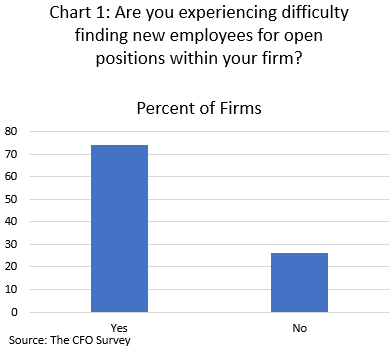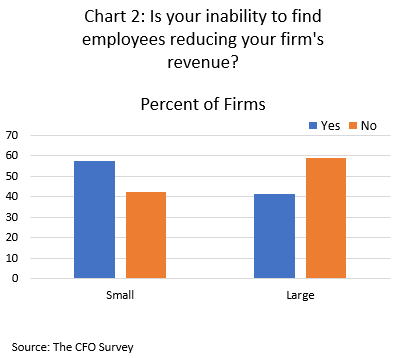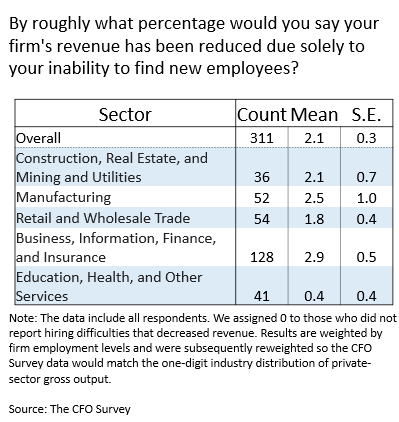The economic recovery from the pandemic-induced downturn of 2020 has been swift in terms of overall spending. It took about one year for real gross domestic product to return to its pre-COVID level. Firms in the latest CFO Survey expect the pattern of strong sales to continue for 2021 and 2022. At the same time, firms report—by a large margin—that their top concern is a shortage of available labor. In this post, we investigate the extent to which labor-availability problems are restraining sales revenue growth. Said another way, could the recovery in spending be even stronger if labor shortages could be resolved?
In this quarter's CFO Survey, we asked firms' financial executives a series of questions designed to uncover just how much a labor shortage has crimped their revenues. We estimate that the labor shortages have reduced economywide sales revenue by 2.1 percent, which suggests that the lack of available labor has reduced nominal private-sector gross output by roughly $738 billion, on an annualized basis (or $184 billion per quarter; see the note below).
Difficulty finding new employees for open positions is widespread, as indicated by three-quarters of the respondents to the July 2021 CFO Survey (see chart 1), a finding consistent with the record levels of unfilled job openings in the Job Openings and Labor Turnover Survey from the U.S. Bureau of Labor Statistics.

Among firms that struggled to find workers (nearly 40 percent of our overall panel), slightly more than half reported that their inability to find employees cost their firm revenues. It also appears, as chart 2 indicates, that smaller firms have been disproportionately affected by labor shortages. Of the small firms (fewer than 500 employees) that struggled to hire employees, nearly 60 percent indicated that labor shortages caused their revenue to suffer, compared to 40 percent of large firms.

Digging even deeper, we posed the following question to the firms indicating that their inability to find employees has reduced revenue: "By roughly what percentage would you say your firm's revenue has been reduced due solely to your inability to find new employees?" The response was a fairly consistent 10 percent across industry groupings for this subset of panelists Aggregated across the full panel (thereby also accounting for firms that have not been affected by hiring difficulties or revenue effects), this decline indicates that labor shortages cost the economy 2.1 percent in nominal sales revenue (or private-sector gross output). Nationally, this impact translates into an annual reduction in gross output of $738 billion.

There does not seem to be just one reason for why workforce participation has remained lower than it was before COVID despite the record number of job openings. For instance, households have had ongoing virus concerns, and many have struggled to find childcare. Also, the share of older workers choosing to retire has risen, and government support payments have made not working relatively less costly than in the past. Nonetheless, the CFO Survey results suggest that labor shortages have burdened firms significantly and could further restrain aggregate economic growth if not resolved.
Note: The figure given in this post earlier was erroneous. The correct estimate of the reduction is $738 billion (or $184 billion per quarter). Nominal gross output for all private industries was $35.18 trillion in the first quarter of 2021 (at seasonally adjusted annualized rates). Multiplying that by 0.021 results in $738 billion (and dividing that by four yields $184 billion per quarter). The U.S. Bureau of Economic Analysis defines nominal gross output for private industries this way: "Principally, a measure of an industry's sales or receipts. These statistics capture an industry's sales to consumers and other final users (found in GDP), as well as sales to other industries (intermediate inputs not counted in GDP). They reflect the full value of the supply chain by including the business-to-business spending necessary to produce goods and services and deliver them to final consumers."








